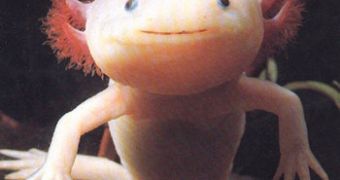The axolotl (Ambystoma mexicanum), a salamander that also goes by the names of the "water monster" or the "Mexican walking fish," was an important element in Aztec legends and diet. As legend has it, the Aztec god of lightning, death and monstrosities, Xolotl, changed into an axolotl and ran into hiding in the Xochimilco lake after hearing he was to be banished or even killed by the other gods. The tiny lizard shares the god's fate, as it is now also facing extinction due to the urbanization of Mexico City, lying on the shores of its natural habitat – Lake Xochimilco.
An adult axolotl has an average size of about 23 centimeters (9.1 inches), with extremes of 15–45 centimeters (5.9–18 inches). They have wide heads with lidless eyes and a mouth in the shape of a benevolent smile, and underdeveloped legs with long digits, and feed on tiny fish, aquatic insects and crustaceans. They are held in high regard by researchers, since they possess some uncommon features, such as the ability to regrow lost limbs, or the fact that they preserve larval features throughout adulthood (like a dorsal fin or external gills). They come in 4 colors, 2 natural and 2 from mutations.
The natural colors are wildtype (different nuances of brown, often with spots) and melanoid (black), while the mutant colors include leucistic (pale pink and black eyes) and albino (tan, golden or pale pink, with pink eyes). The sewage dumped in the lake, together with the invasive new species of fish (African tilapia and Asian carp) contribute to the rapid disappearance of the salamander. The fish steal its food and eat its young, dirtying the waters along the way. These factors have reduced axolotl population of millions of individuals, from 1,500 per square mile in 1998, to barely 25 per square mile now.
"If the axolotl disappears, it would not only be a great loss to biodiversity but to Mexican culture, and would reflect the degeneration of a once-great lake system," explains Luis Zambrano, a biologist from the Autonomous University of Mexico. There are two different approaches to saving the axolotl, but choosing one takes more time than actually saving the salamander. One refers to isolating specimens in safe sanctuaries, where carp has no access, while the other involves breeding axolotls in captivity and then releasing them into the wild, but this has to be further studied for the possibility of genetic problems occurring.

 14 DAY TRIAL //
14 DAY TRIAL //